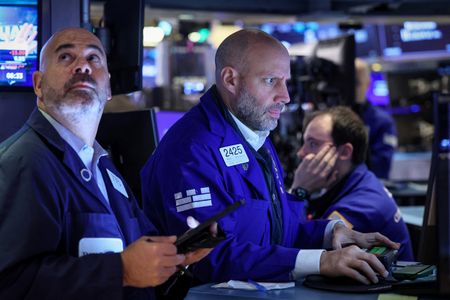By Jamie McGeever
ORLANDO, Florida (Reuters) -Fears that high and rising Treasury yields will pummel Wall Street are understandable, but ultimately misplaced – history shows that the link between yields and stocks ranges from patchy at best, to non-existent.
Stocks have fallen as much as 10% since July as bond yields have shot up sharply, but beyond that immediate correction, the outlook is more encouraging.
The third-quarter earnings season underway shows profit growth of around 5%, while the bullish 2024 outlook has held up firmly – analysts are still penciling in earnings growth of around 12%.
That’s in a world with bond yields up over 100 basis points in the last three months to their highest since 2006-07, and the entire yield curve briefly trading above 5.00% recently.
Credit spreads have remained remarkably well-contained too, another sign that corporate America appears to be handling the dramatic rise in bond yields pretty well.
While puzzling to many analysts, this is more the norm than the exception.
If the cost of money is high because inflation is being driven by decent economic growth, stocks will do well; if the cost of money and inflation are high with growth struggling, the challenge for stocks is greater, but not insurmountable.
“Over the past 60 years there is basically no relationship between the average level of yields and S&P 500 returns, at least at a quarterly frequency,” says Stuart Kaiser, head of equity trading strategy at Citi.
“It’s getting to those new higher levels that hurts.”
The chart below from Kaiser and his colleagues shows the relationship between average quarterly S&P 500 returns and average 10-year yields every quarter going back to 1962. If there is a pattern, it is almost impossible to spot.
The correlation between equity returns and real yields since 1999 is equally hit-or-miss.
NO ROOM FOR DOOM
The signal stocks receive from high bond yields may depend on why they are elevated. If yields are high due to inflation fears, stocks may struggle; if it is due to strong growth, stocks will generally do better.
Investors right now may be caught between the two schools of thought.
Research by Callie Cox, investment analyst at eToro, shows that since 1962, there have been 66 months where the 10-year Treasury yield has risen by half a percentage point or more.
The S&P 500 fell in the year following 20 of those months, was unchanged a year after one of them, and rose in the year following 45 of them.
Slicing the data in a slightly different way, Cox calculates that there have been 50 three-month periods since 1962 where the 10-year yield has risen half a percentage point or more, including the August-October period this year.
The S&P 500’s performance in the subsequent 12 months was higher 35 times, lower 14 times, and flat once. The average 12-month return was 8.1%, and the median 12-month return 12.1%.
“Rising rates don’t necessarily need to doom the stock market,” Cox says. “Investors get uncomfortable when yields start moving higher, they feel the ground moving beneath their feet. But long term, higher yields usually point to a stronger economy, and rising profits.”
That said, the speed of change in yields can be damaging, as can be seen in the recent performance of sectors and indices more sensitive to the risk-free rate: the Nasdaq fell 12% in the three months through October, and the Russell 2000 fell nearly 20%.
Indeed, the Russell 2000’s underperformance relative to the S&P 500 now is the greatest since 2001.
Analysis by Truist Advisory Services shows that in the period from 1950 to 2007, just before the Great Financial Crisis crushed yields for 15 years, the 10-year Treasury yield averaged 6.2%, the 3-month T-bill averaged 5.0%, and inflation averaged 3.8%.
The S&P 500’s annualized compounded return over the full period? 11.9%.
“Stocks and companies historically have adapted and done just fine in a higher rate and inflation backdrop than what we all became accustomed to over the period following the GFC,” Truist analysts wrote in a note on Oct. 23.
Perhaps all this shows is that stocks go up most years. But those years include bouts of high and rising bond yields too.
(The opinions expressed here are those of the author, a columnist for Reuters.)
(By Jamie McGeever; Editing by Andrea Ricci)

